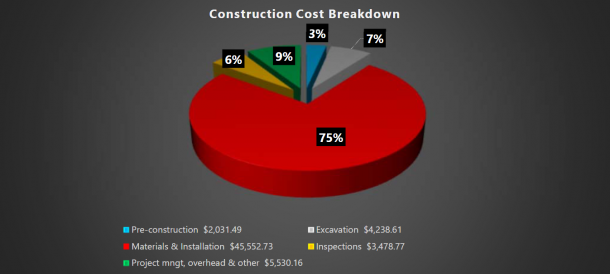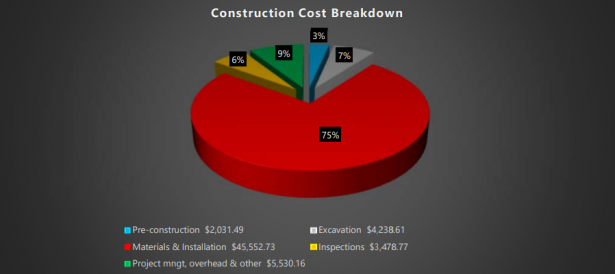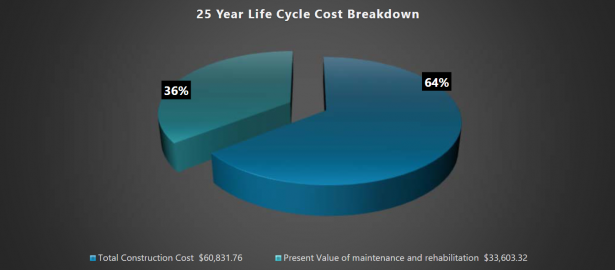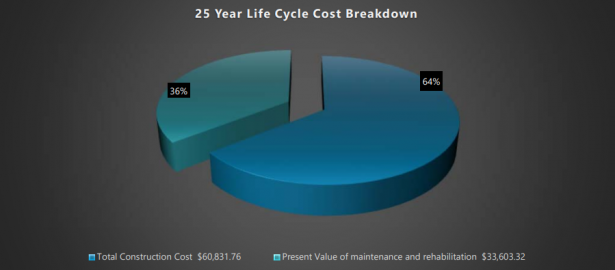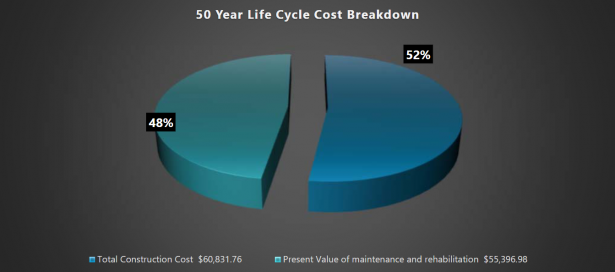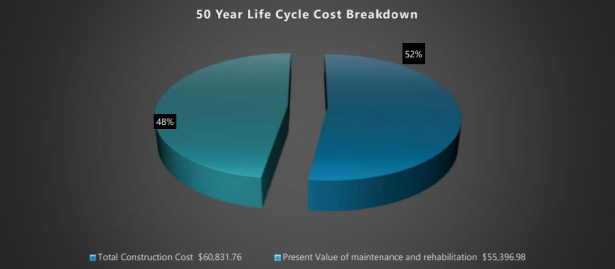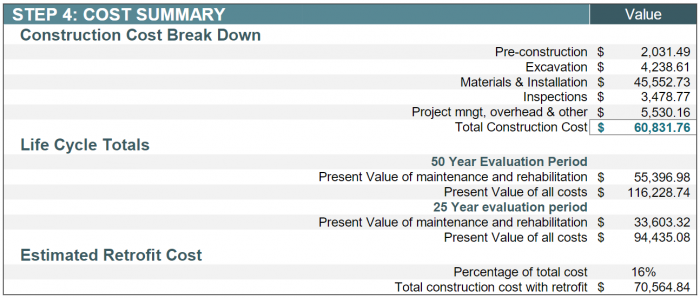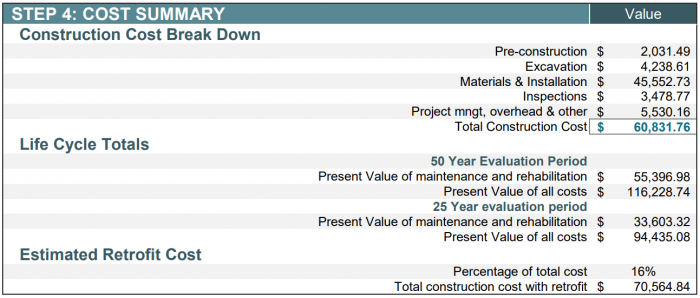Difference between revisions of "Infiltration Chamber: Life Cycle Costs"
Dean Young (talk | contribs) |
Dean Young (talk | contribs) |
||
| Line 15: | Line 15: | ||
* Native soil infiltration rates for Full, and Partial Infiltration Design scenarios were assumed to be 20 mm/h and 10 mm/h respectively, and a safety factor of 2.5 was applied to calculate the design infiltration rate. | * Native soil infiltration rates for Full, and Partial Infiltration Design scenarios were assumed to be 20 mm/h and 10 mm/h respectively, and a safety factor of 2.5 was applied to calculate the design infiltration rate. | ||
* Operation and maintenance (O&M) cost estimates assume annual inspections, removal of trash and debris twice a year, and removal of sediment from pretreatment structures annually. Verification inspections are included every 5 years to confirm adequate maintenance, and every 15 years to confirm adequate drainage performance through in-situ chamber system water level monitoring during natural storm events. | * Operation and maintenance (O&M) cost estimates assume annual inspections, removal of trash and debris twice a year, and removal of sediment from pretreatment structures annually. Verification inspections are included every 5 years to confirm adequate maintenance, and every 15 years to confirm adequate drainage performance through in-situ chamber system water level monitoring during natural storm events. | ||
| − | * Hydrodynamic separators ([[Oil and Grit Separator| oil and grit separators]] and isolated chamber row as [[Pretreatment| pretreatment]]. | + | * Hydrodynamic separators ([[Oil and Grit Separator|oil and grit separators]]) and isolated chamber row as [[Pretreatment| pretreatment]]. |
* Infiltration chamber system length of 5 metres. | * Infiltration chamber system length of 5 metres. | ||
* Infiltration chamber system height of 0.762 metres. | * Infiltration chamber system height of 0.762 metres. | ||
Revision as of 21:46, 22 December 2022
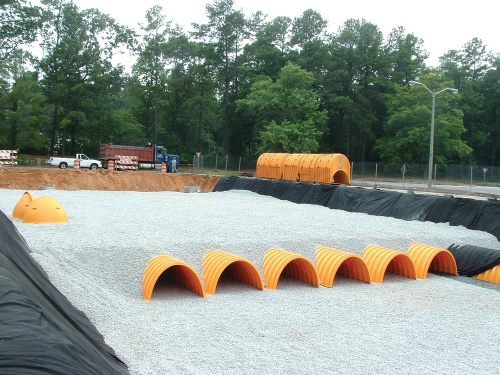
Overview[edit]
Infiltration chambers include a range of proprietary manufactured, modular structures installed underground (embedded in clean, crushed angular stone) to create large void spaces that temporarily store and infiltrate runoff into the underlying native soil. Typically installed under parking or landscaped areas, they can be used in various configurations. They are well suited to sites where available land area is limited, or where it is desirable for the facility to have a minimal surface footprint. They can be designed with enough load bearing capacity to support the weight of structures above them, meaning that they can be installed below parking lots, sports fields, etc. STEP has prepared life cycle costs estimates for infiltration chamber systems located on highly permeable native soil (Full Infiltration design), and moderately permeable native soil (Partial Infiltration design) scenarios for comparison. Cost estimates are based on a 2,000 m2 asphalt drainage area, runoff control target of 25 mm depth and 82 and 163 hour drainage periods for Full and Partial Infiltration Design scenarios respectively, which can be viewed below. To generate your own life cycle cost estimates customized to the development context, design criteria, and constraints applicable to your site, access the updated LID Life Cycle Costing Tool (LCCT) here.
Design Assumptions[edit]
Infiltration chambers are an ideal technology for installing below any type of surface or landscape suitable for receiving and infiltrating large volumes of stormwater. Components typically include proprietary chamber system parts that provide large water storage volume per unit area, clear stone aggregate to construct base and embed chambers, geotextile, pretreatment devices, and structures to access inlets, outlets, pretreatment devices and the chambers themselves for operation and maintenance. Optional components include a flow restrictor to control the release rate of the facility, and surface drains to safely convey flows in excess of the storage capacity of the design.
Design and operation and maintenance program assumptions used to generate cost estimates are based on tool default values and the following STEP recommendations:
- Native soil infiltration rates for Full, and Partial Infiltration Design scenarios were assumed to be 20 mm/h and 10 mm/h respectively, and a safety factor of 2.5 was applied to calculate the design infiltration rate.
- Operation and maintenance (O&M) cost estimates assume annual inspections, removal of trash and debris twice a year, and removal of sediment from pretreatment structures annually. Verification inspections are included every 5 years to confirm adequate maintenance, and every 15 years to confirm adequate drainage performance through in-situ chamber system water level monitoring during natural storm events.
- Hydrodynamic separators (oil and grit separators) and isolated chamber row as pretreatment.
- Infiltration chamber system length of 5 metres.
- Infiltration chamber system height of 0.762 metres.
- 50 mm dia. clear stone aggregate bedding depth (below and above chamber system) of 152 millimetres.
- Two (2) maintenance holes providing access to infiltration chamber system inlet and outlet structures.
Notes[edit]
- Designs include pretreatment through hydrodynamic separator (Oil and Grit Separator and A "Sediment Trap" or Isolated chamber row).
- The tool calculates costs for new (greenfield) development contexts and includes costs for contractor overhead and profit, material, delivery, labour, equipment (rental, operating and operator costs), hauling and disposal.
- Land value and equipment mobilization and demobilization costs are not included, assuming BMP construction is part of overall development site construction.
- Design and Engineering cost estimates are not calculated by the tool and must be supplied by the user.
- The tool adds 10% contingency and additional overhead as default.
- All cost estimates are in Canadian dollars and represent the net present value (NPV) as the tool takes into account average annual interest and discount rates over the 25 and 50 year operating life cycle periods.
- Unit costs are based on 2018 RSMeans standard union pricing.
- Cost for piping from roof to system, parking lot to system and overflow from system are not included in this costing.
- Costs of the control manhole and overflow, and pre-treatment via an OGS (when the facility takes road runoff) are included.
- Additional costs associated with retrofit or redevelopment contexts is assumed to be 16% of the cost estimate for new (greenfield) construction contexts.
- Retrofit construction cost estimates are included in the 'Costs Summary' section for comparison.
- Retrofit construction cost estimates are included in the 'Costs Summary' section for comparison.
Construction Costs[edit]
Note: Please click on each image to enlarge to view associated construction cost estimates.
Above you can find a cost breakdown of a 1000m2 in two different configurations:
As can be seen, regardless of design configuration, Material & Installation expenses represent the largest portion of total construction costs (75%).
Life Cycle Costs[edit]
Below are capital and life cycle cost estimates for the two infiltration chamber configurations over 25- and 50-year time periods. The estimates of maintenance and rehabilitation (life cycle) costs represent net present values. Operation and maintenance costs are predicted to represent 36% of total life cycle costs over the 25-year evaluation period, and increase to 48% of total life cycle costs over the 50-year period, due to increased levels of litter removal, clean out and disposal of collected sediment from the Isolated chamber row (every 4 - 8 years), cleaning out the catchbasin and the Oil and Grit Separator/Hydrodynamic Separator annually.
25-Year life cycle cost break down[edit]
Note: Click on each image to enlarge to view associated life cycle cost estimate.
50-Year life cycle cost break down[edit]
Note: Click on each image to enlarge to view associated life cycle cost estimate.
Cost Summary Tables[edit]
Total life cycle cost estimates for the two infiltration chamber configurations are the exact same with the total being ($60,831.76).
Full Infiltration[edit]
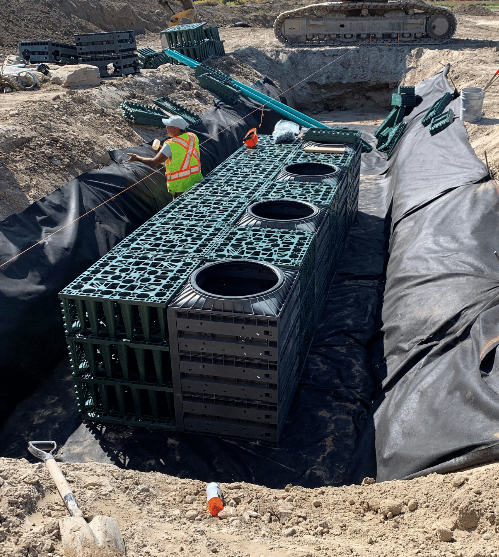
Partial Infiltration[edit]
References[edit]
- ↑ Sustainable Technologies Evaluation Program (STEP) 2015. Evaluation of Underground Stormwater Infiltration Systems. Technical Brief. Toronto and Region Conservation Authority. Toronto, Ontario. https://sustainabletechnologies.ca/app/uploads/2015/04/UndergroundInfiltrationSystems_TechBrief_April2015.pdf
- ↑ Young, D. Van Seters, T., Graham, C. 2013. Evaluation of Underground Stormwater Infiltration Systems. Toronto and Region Conservation Authority. Toronto, Ontario. https://sustainabletechnologies.ca/app/uploads/2013/03/Infiltration-Chambers-and-Trenches_2013-Final.pdf
